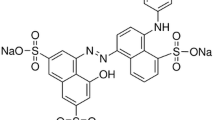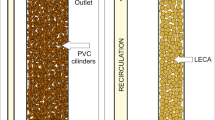Abstract
The ability of the NAR-2 bacterial consortium, consisting of A1, C1, and L17, to degrade the azo dye model, Remazol Black B (RBB), was studied in an upflow packed-bed reactor for continuous sequential microaerophilic–aerobic batch operations. Continuous decolourisation was performed in a borosilicate glass column (12 mm × 20 mm) packed with surfactant-modified clinoptilolite immobilised by the NAR-2 bacterial consortium. In column bioreactor studies, decolourisation was observed at 45 °C and was carried out by varying the flow rates and dye concentrations in a modified P5 medium with pH 7.0 under microaerophilic conditions. A decolourisation of 95.87 % of 0.1 g/L RBB was achieved at a flow rate of 0.2 mL/min under microaerophilic conditions by the immobilised NAR-2 bacterial consortium. An analysis of the decolourised and biodegradation products of the RBB using total aromatic amines showed that a reduction in the RBB resulted in the formation of aromatic amines. On further aerobic degradation for 15 days, the concentration of the amines dropped significantly, from an initial concentration of 34 to 11 mg/L, following the aerobic batch treatment experiment. The findings of this study showed that SMC can be a support material for bacterial cell immobilisation in a single upflow reactor with intermittent microaerophilic–aerobic operations, and it was found to be suitable and eco-friendly for the degradation of azo dyes.










Similar content being viewed by others
References
Ab.llah N (2012) Surfactant modified clinoptilolite immobilised with bacterial consortium for efficient and ecofriendly decolourisation of acid red 27. Master thesis. Universiti teknologi Malaysia, Skudai
Akay G, Erhan E, Keskinler B (2005) Bioprocess intensification in flow-through monolithic microbioreactors with immobilized bacteria. Biotechnol Bioeng 90:180–190
Aksu Z, Donmez G (2005) Combined effects of molasses sucrose and reactive dye on the growth and dye bioaccumulation properties of Candida tropicalis. Process Biochem 40:2443–2454
Amosa MK, Jami MS, Alkhatib MAFR, Tajari T, Jimat DN, Owolabi RU (2016) Turbidity and suspended solids removal from high-strength wastewater using high surface area adsorbent: mechanistic pathway and statistical analysis. Cogent Eng 3(1):1162384
Bakhshi Z, Najafpour G, Neya BN, Kariminezhad ER, Pishgar Moosavi N (2011) Recovery of upflow anaerobic packed bed reactor from high organic load during startup for phenolic wastewater treatment. Chem Ind Chem Eng Q 17(4):517–524
Buitron G, Quezada M, Moreno G (2004) Aerobic degradation of the azo dye acid red 151 in a sequencing batch biofilter. Bioresour Technol 92:143–149
Byberg R (2012). Photocatalytic degradation of a series of direct azo dyes using immobilized TiO2. Doctoral dissertation. Worcester Polytechnic Institute
Chan GF, Rashid NA, Koay LL, Chang SY, Tan WL (2011) Identification and optimization of novel NAR-1 bacterial consortium for the biodegradation of Orange II. Insight Biotechnol 1(1):7–16
Chan GF, Rashid NAA, Chua LS, Nasiri R, Ikubar MRM (2012) Communal microaerophilic–aerobic biodegradation of Amaranth by novel NAR-2 bacterial consortium. Bioresour Technol 105:48–59
Chen BY, Chang J-S (2007) Assessment upon species evolution of mixed consortia for azo dye decolorization. J Chin Inst Chem Eng 38:259–266
Chen KC, Wu JY, Liou DJ, Hwang SCJ (2003) Decolorization of the textile dyes by newly isolated bacterial strains. J Biotechnol 101(1):57–68
Chen BY, Wang YM, Ng IS (2011) Understanding interactive characteristics of bioelectricity generation and reductive decolorization using Proteus hauseri. Bioresour Technol 102(2):1159–1165
Firmino PIM, da Silva MER, Mota FSB, dos Santos AB (2011) Applicability of anthraquinone-2,6-disulfonate (AQDS) to enhance colour removal in mesophilic UASB reactors treating textile wastewater. Braz J Chem Eng 28(4):617–624
Forgacs E, Cserháti T, Oros G (2004) Removal of synthetic dyes from wastewaters: a review. Environ Int 30:953–971
Ghiaci M, Abbaspur A, Kia R, Seyedeyn-Azad F (2004) Equilibrium isotherm studies for the sorption of benzene, toluene, and phenol onto organo-zeolites and as- synthesized MCM-41. Sep Purif Technol 40:217–229
Hentzer M, Teitzel GM, Balzer GJ, Heydorn A, Molin S, Givskov M, Parsek MR (2001) Alginate overproduction affects Pseudomonas aeruginosa biofilm structure and function. J Bacteriol 183:5395–5401
Heydorn A, Ersboll B, Kato J, Hentzer M, Parsek MR, Tolker-Nielsen T, Givskov M, Molin S (2002) Statistical analysis of Pseudomonas aeruginosa biofilm development: impact of mutations in genes involved in twitching motility, cell-to-cell signaling, and stationary-phase sigma factor expression. Appl Environ Microbiol 68:2008–2017
Hrenovic J, Rozic M, Sekovanic L, Anic-Vucinic A (2008) Interaction of surfactant-modified zeolites and phosphate accumulating bacteria. J Hazard Mater 156:576–582
Işik M, Sponza DT (2003) Effect of oxygen on decolorization of azo dyes by Escherichia coli and Pseudomonas sp. and fate of aromatic amines. Process Biochem 38(8):1183–1192
Işık M, Sponza DT (2004) A batch kinetic study on decolorization and inhibition of Reactive Black 5 and Direct Brown 2 in an anaerobic mixed culture. Chemosphere 55(1):119–128
Jadhav SB, Patil NS, Watharkar AD, Apine OA, Jadhav JP (2013) Batch and continuous biodegradation of Amaranth in plain distilled water by P. aeruginosa BCH and toxicological scrutiny using oxidative stress studies. Environ Sci Pollut Res 20(5):2854–2866
Joshi T, Iyengar L, Singh K, Garg S (2008) Isolation, identification and application of novel bacterial consortium TJ-1 for the decolorization of structurally different azo dyes. Bioresour Technol 99:7115–7121
Kalyani DC, Telke AA, Dhanve RS, Jadhav JP (2009) Ecofriendly biodegradation and detoxification of Reactive Red 2 textile dye by newly isolated Pseudomonas sp. SUK1. J Hazard Mater 163(2):735–742
Kardi SN, Ibrahim N, Rashid NAA, Darzi GN (2016) Simultaneous acid red 27 decolourisation and bioelectricity generation in a (H-type) microbial fuel cell configuration using NAR-2. Environ Sci Pollut Res Int 23(4):3358–3364
Khan R, Banerjee UC (2010) Decolorization of azo dyes by immobilized bacteria. In: Biodegradation of azo dyes. Springer, Berlin, Heidelberg, pp 73–84
Klepacz-smółka A, Paździor K, Ledakowicz S, Sójka-ledakowicz J, Mrozińska Z, Żyłła R (2009) Kinetic studies of decolourisation of concentratesFromnanofiltration treatment of real textile effluents in anaerobic/aerobic sequencingbatch reactors. Environ Protect Eng 35(3):1–11
Lee SY, Cho WJ, Kim KJ, Ahn JH, Lee M (2005) Interaction between cationic surfactants and montmorillonites under nonequilibrium condition. J Colloid Interface Sci 284(2):667–673
Libra JA, Borchert M, Vigelahn L, Storm T (2004) Two stage biological treatment of a diazo reactive textile dye and the fate of the dye metabolites. Chemosphere 56(2):167–180
Méndez-Paz D, Omil F, Lema JM (2005) Anaerobic treatment of azo dye Acid Orange 7 under batch conditions. Enzyme Microb Technol 36(2–3):264–272
Mi-Na Z, Xue-Pin L, Bi S (2006) Adsorption of surfactants on chromium leather waste. J Soc Leather Technol Chem 90:1
Muyibi SA, Tajari T, Jami MS, Amosa MK (2014) Removal of organics from treated palm oil mill effluent (POME) using powdered activated carbon (PAC). Adv Environ Biol 8(3):590–596
Nessler J (1868) Ueber Bestimmung des Ammoniaks und der Salpetersäure in sehr verdünnten Lösungen. Fresenius’ J Anal Chem 7(1):415–416
Plum A, Braun G, Rehorek A (2003) Process monitoring of anaerobic azo dye degradation by high-performance liquid chromatography–diode array detection continuously coupled to membrane filtration sampling modules. J Chromatogr A 987(1):395–402
Rehorek A, Plum A (2006) Online LC-MS–MS process monitoring for optimization of biological treatment of wastewater containing azo dye concentrates. Anal Bioanal Chem 384(5):1123–1128
Saratale RG, Saratale GD, Chang JS, Govindvar SP (2011) Bacterial decolorization and degradation of azo dyes: a review. J Taiwan Inst Chem E 42:138–157
Scott GV (1968) Spectrophotometric determination of cationic surfactants with Orange II. Anal Chem 40(4):768–773
Selcuk H (2005) Decolourization and detoxification of textile wastewater by ozonation and coagulation processes. Dyes Pigment 64:217–222
Senan RC, Shaffiqu TS, Roy JJ, Abraham TE (2003) Aerobic degradation of a mixture of azo dyes in a packed bed reactor having bacteria-coated laterite pebbles. Biotechnol Prog 19:647–651
Sharma DK, Saini HS, Singh M, Chimni SS, Chadha BS (2004) Biological treatment of textile dye acid violet-17 by bacterial consortium in an up-flow immobilized cell bioreactor. Lett Appl Microbiol 38:345–350
Sponza DT, Işık M (2005) Toxicity and intermediates of CI Direct Red 28 dye through sequential anaerobic/aerobic treatment. Process Biochem 40(8):2735–2744
Tan NCG (2001) Integrated and sequential anaerobic/aerobic biodegradation of azo dyes. Environmental technologies to treat sulfur pollution—principles and engineering. http://agris.fao.org/aos/records/NL2001001853
Tony BD, Goyal D, Khanna S (2009) Decolorization of Direct Red 28 by mixed bacterial culture in an up-flow immobilized bioreactor. J Ind Microbiol Biotechnol 36:955–960
Vaidya AA, Datye KV (1982) Environmental pollution during chemical processing of synthetic fiber. Colorate 14:3–10
Van der Zee FP, Villaverde S (2005) Combined anaerobic–aerobic treatment of azo dyes—a short review of bioreactor studies. Water Res 39(8):1425–1440
Verma P, Madamwar D (2003) Decolourization of synthetic dyes by a newly isolated strain of Serratia marcescens. World J Microbiol Biotechnol 19(6):615–618
Wang L, Langley D (1975) Determining cationic surfactant concentration. Prod R D 14:210–212
Wang H, Zheng XW, Su JQ, Tian Y, Xiong XJ, Zheng TL (2009) Biological decolorization of the reactive dyes Reactive Black 5 by a novel isolated bacterial strain Enterobacter sp. EC3. J Hazard Mater 171(1):654–659
Warchoł J, Misaelides P, Petrus R, Zamboulis D (2006) Preparation and application of organo-modified zeolitic material in the removal of chromates and iodides. J Hazard Mater 137:1410–1416
Zhao M, Sun PF, Du LN, Wang G, Jia XM, Zhao YH (2014) Biodegradation of methyl red by Bacillus sp. strain UN2: decolorization capacity, metabolites characterization, and enzyme analysis. Environ Sci Pollut Res 21(9):6136–6145
Zouari-Mechichi H, Mechichi T, Dhoui A, Sayad S, Martínez AT, Martínez MJ (2006) Laccase purification and characterization from Trametes trogiiisolated in Tunisia: decolorization of textile dyes by the purified enzyme. Enzyme Microb Technol 39:141–148
Acknowledgments
The author wishes to acknowledge the Ministry of Science, Technology and Innovation for providing the TechnoFund Grant, Vote No., 4H009, Malaysia. And thank the support of the Ministry of Higher Education, for the Exploratory Research Grant Scheme (ERGS), Vote No., 4L144, Malaysia, to carry out the present research and to Universiti Teknologi Malaysia (UTM) for providing the laboratory facilities.
Author information
Authors and Affiliations
Corresponding authors
Rights and permissions
About this article
Cite this article
Kardi, S.N., Rashid, N.A.A., Ibrahim, N. et al. Biodegradation of Remazol Black B in sequential microaerophilic–aerobic operations by NAR-2 bacterial consortium. Environ Earth Sci 75, 1172 (2016). https://doi.org/10.1007/s12665-016-5984-8
Received:
Accepted:
Published:
DOI: https://doi.org/10.1007/s12665-016-5984-8




